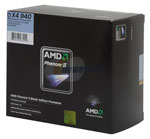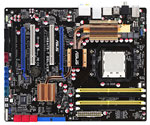AMD Performance Midrange
The introduction of Phenom II has made putting together an AMD Performance Midrange a joy again. While the Phenom was an honest competitor at the price points where AMD chose to compete, the poor overclocking of the AMD Phenom compared to Intel Core 2 dual/quad-core processors was always a nagging reality. Phenom II changes all that, and AMD in 45nm clothes is once again a screaming overclocker. We reached 3.9GHz in our testing for the Phenom II launch with a Phenom II 940 CPU. That same CPU is the starting point for our AMD Performance Midrange PC.
| AMD Performance Midrange PC | ||
| Hardware | Component | Price |
| Processor | Phenom II x4 940 Black Edition (3.0GHzx4 125W 4x512KB L2, 6MB L3) |
$275 |
| Cooling | Tuniq Tower 120 | $46 |
| Video | SAPPHIRE 100251SR Radeon HD 4870 X2 | $400 |
| Motherboard | ASUS M3A79-T Deluxe | $189 |
| Memory | G Skill DDR2-1100 (PC2-8800) 4GB Memory Kit F2-8800CL5D-4GBPI | $90 |
| Hard Drive | Seagate Barracuda 7200.11 ST310000333AS 1TB | $110 |
| Optical Drive | LG BD/HD DVD / 16x DVD+/- RW GGC-H20LK | $99 |
| Audio | Creative 7.1 Sound Blaster X-FI Titanium | $90 |
| Case | Antec Nine Hundred Black Steel ATX Mid Tower | $100 |
| Power Supply | SILVERSTONE ST70F 700W SLI Ready CrossFire Ready 80 PLUS Certified Modular Active PFC Power Supply | $100 |
| Display | ASUS VW246H Black 24" 2ms(GTG) HDMI Widescreen LCD Monitor (1920x1080) | $290 |
| Speakers | Logitech G51 155 watts RMS 5.1 Surround Sound Speakers | $90 |
| Input | Microsoft CA9-00001 Black PS/2 Standard Keyboard and Optical USB/PS2 Mouse - OEM | $16 |
| Operating System | Microsoft Vista Home Premium OEM | $99 |
| Bottom Line | $1994 | |
 |
You can read our review of the Phenom II X4 for additional information. The Phenom II 940 X4 at 3.0GHz is the fastest of the currently shipping AMD Phenom II processors. The Phenom II is very similar in L2/L3 cache configuration to the recently introduced Intel Core i7. Performance is also comparable to the best Intel chips. As the first 45nm AMD processors the Phenom II also overclocks very well, finally approaching the overclocking levels enjoyed by Intel since the introduction of the Core 2 Duo.
 |
We've paired the Phenom II 940 with the superb ASUS M3A79-T Deluxe. At $190 the ASUS is not cheap or even a great value for a 790FX/SB750 setup, but it is one of the most loaded and best performing AMD boards we have used this year. ASUS loads the board with Gigabit LAN, IEEE 1394 support, four PCI-E x16 slots (dual x16, tri x16/x8/x8, or quad x8), two PCI slots, a single eSATA port, and six 3Gb/s SATA ports featuring RAID 0/1/10/5. The M3A79-T Deluxe also works very well with Phenom II and end-users will not be disappointed in performance or overclocking capabilities.
The ASUS also includes superb onboard sound with the ADI AD2000B 8-channel HD audio. This is probably the best onboard sound solution we have tested so far. A Creative 7.1 Sound Blaster X-FI Titanium audio card was included in the components mostly for game compatibility. You can save $90 and use the onboard ADI sound without sacrificing much if anything in sound quality.
 |
The GPU choice is the top-performing Sapphire 100251SR Radeon HD 4870X2. This dual-GPU card is an exceptional performer on the 790FX chipset, as you would expect. The selling price has been around $500, but with current promotions you can buy this Sapphire 4870X2 for just $400. That is an exceptional buy that delivers top performance at a very fair price, and if you ever want more gaming power a quad-GPU (two 4870X2 cards) is an option, albeit one we don't really recommend unless you have a 30" LCD.
The Tuniq Tower 120 cooler was also used on the AMD Value Midrange System described on page 4. The rest of the components are the same as the Intel Performance Midrange PC. This includes the Seagate 1TB hard drive, the LG GGC-H20LK BD/HD reader and 16X DVD burner, the Antec Nine Hundred case, the Silverstone 700W PSU, the Logitech G51 powered speakers, the ASUS 1080p 24" 1920x1080 LCD Monitor, the Microsoft OEM keyboard/optical mouse, and Microsoft Vista Home Premium OEM. You can find more information on these choices on the previous Intel Performance Midrange page or on page 3.










77 Comments
View All Comments
7Enigma - Monday, January 12, 2009 - link
I've never heard of this and 20min of searching Anandtech doesn't show it in any CPU cooler roundups that I can find? The Xigmatek AIO or something does show up but clearly this is a different part. Could someone link me to an Anand article that has a review of it?7Enigma - Wednesday, January 14, 2009 - link
Anyone interested see Christof's reply on (now) page 6. Apparently while never written up in an Anand article the cooler was tested in-house and did very well for the $.7Enigma - Wednesday, January 14, 2009 - link
*Mr. Fink was actually the person whom tested the cooler. Edit button, EDIT BUTTON, G-D edit button!7Enigma - Monday, January 12, 2009 - link
$190 E8500$165 E8400
Is there any real benefit to the E8500 over the E8400? I plan on a modest OC, likely not looking to increase the voltage (maybe slightly), is there something I'm missing since the stock frequency seems to be under 200MHz, and the cache size is the same?
Thanks.
Jynx980 - Monday, January 12, 2009 - link
Good guide. I am planning on building a similar system as the Intel Midrange system. I would like to see power draw and acoustic info though. Why are the CPU heatsinks referred to as Rifle coolers?Typo?:the E8600 has been matched with components that are also excellent choices for overclocking.
Jynx980 - Monday, January 12, 2009 - link
I am also curious if CPU and video card prices will get a bit of a shuffle soon with the new Phenom and GTX 295.jasonb - Monday, January 12, 2009 - link
Phenom II is 4x 512 KB, not 4x 512 MB.IHateMyJob2004 - Monday, January 12, 2009 - link
I would love to have someone write up an article (or articles) that revolves around the idea of data storage at home.these days, my concerns are with the following:
1) perosnal finances
2) images (digital cameras are popular these days)
3) videos ($300 for a good digital camcorder)
4) music (all those with iPods step forward)
None of this is processor heavy, but requires alot of disk space. And since alot of important data is on there, backups are also needed.
So, maybe come up with various price points with requirements for backup.
Low end could be simple backup on an external drive.
Mid end could be the same but with more storage
High end could be crazy (raid 0+1?) and include multiple backups.
And some sort of plan for offsite backup (optional) for each build. The high end could use an online service while the low end could just include an extra external hard drive which is kept at another location.
System builds like this do not exist and I want it and I'm sure alot of us ex-gamers (now 30+ year old parents) have much different concerns than the college crowd.
garydale - Monday, January 12, 2009 - link
OK, I can appreciate that a lot of people are looking for game machines, but there are also those of us who are looking for machines to do office work, touch up pictures, and edit home videos. Moreover, if you're not stuck on Windows, you can try other things that can give you a nice performance boost.None of the machines here use what I consider to be all but obligatory nowadays - a RAID array. Of course, using Linux makes setting up a nice 3-disk or 4-disk RAID5 array easy and cheap. And it really boosts your read performance, something even gamers can appreciate. Since HD access is a real bottleneck, going for a RAID array makes sense.
Secondly, how about going to a real 64bit operating system? Even the 64bit Vista usually has you running 32bit programs. With Linux however you get 64bit right the way through without having to worry about driver or program compatibility (I'm running Debian/Lenny on my workstation which, although still in "testing", is far more stable than the antique XP, let alone Vista).
Admittedly, 64bits doesn't always buy you a lot of extra performance, but in the real world, it's a free upgrade. And sometimes it can get you a big payback while it rarely costs you any performance.
Anyway, I consider my system to be midrange but it costs less than the lower cutoff point, with the 3 HDs, quad-core processor and (if I needed a new one) display being the only expensive parts. Since I'm not a gamer, I didn't bother with a video card. The onboard video handles full-screen HD video nicely so why bother? This also allows me to use the wonderfully economical and quiet PC Power & Cooling Silencer 370 power supply.
Another cost savings is to use a KVM switch instead of a monitor. Some people are connecting multiple monitors up to a single computer, so obviously this isn't a general solution, but with Linux providing multiple virtual desktops, I find that a single monitor for multiple machines works well. And certainly a reasonable KVM saves money and desk space over multiple keyboard, mouses and monitors.
7Enigma - Monday, January 12, 2009 - link
Mr. Fink,Can you recommend a good PSU in the 500-550w range? I've been waiting for the 2nd part of the PSU reviews that have that range as I feel the 750w is overkill for my single gpu build. Maybe send Mr. Katzer an email since he did the 350-400 article?